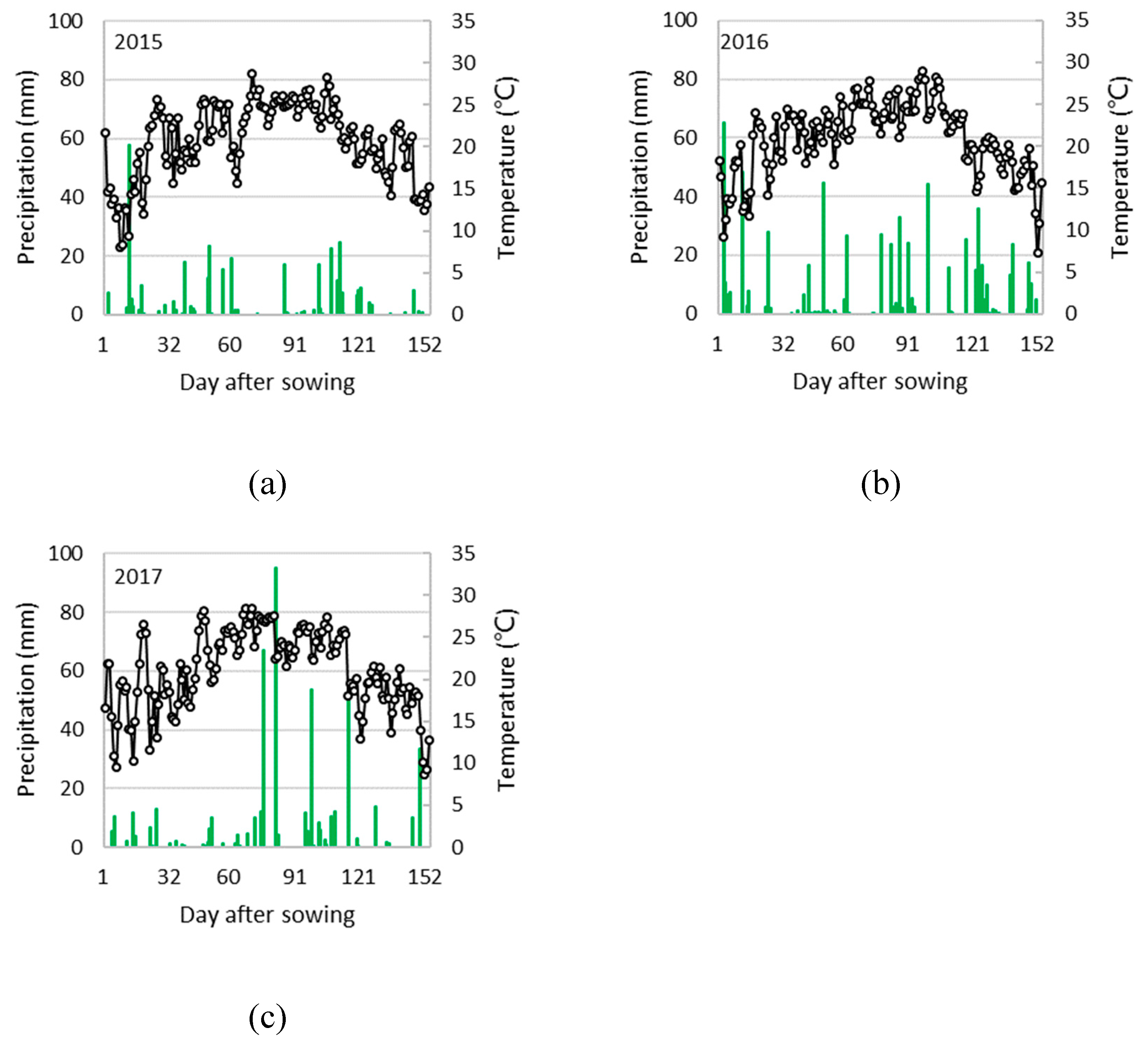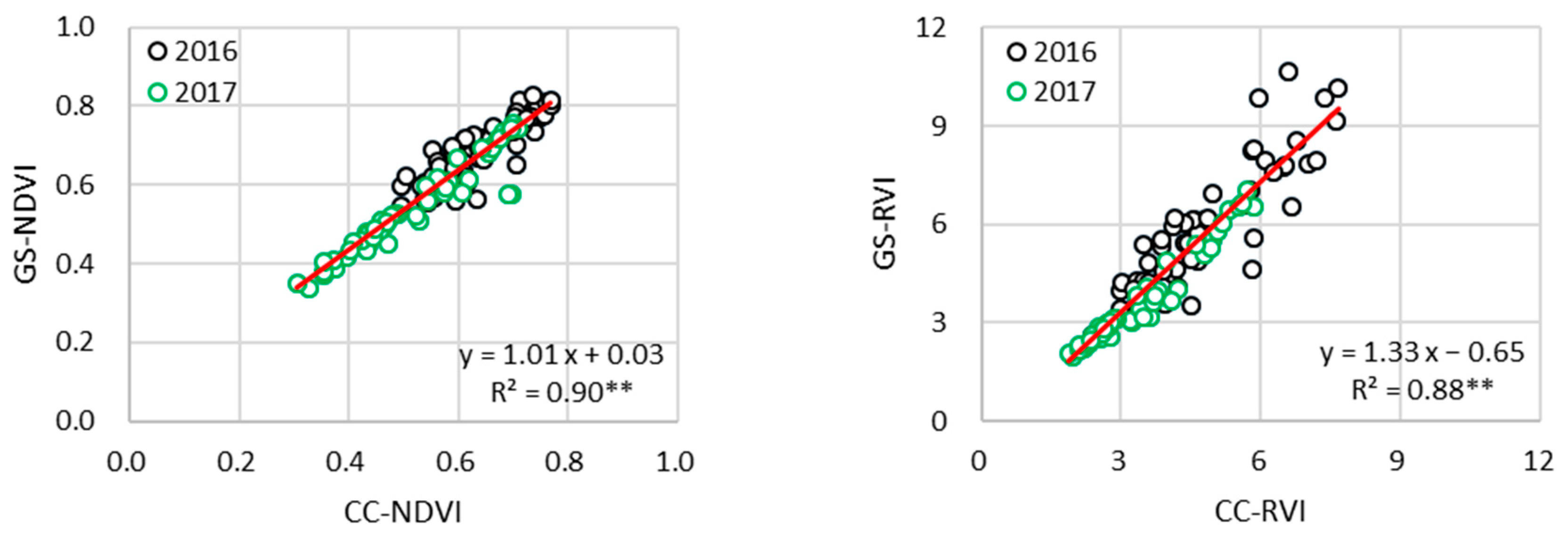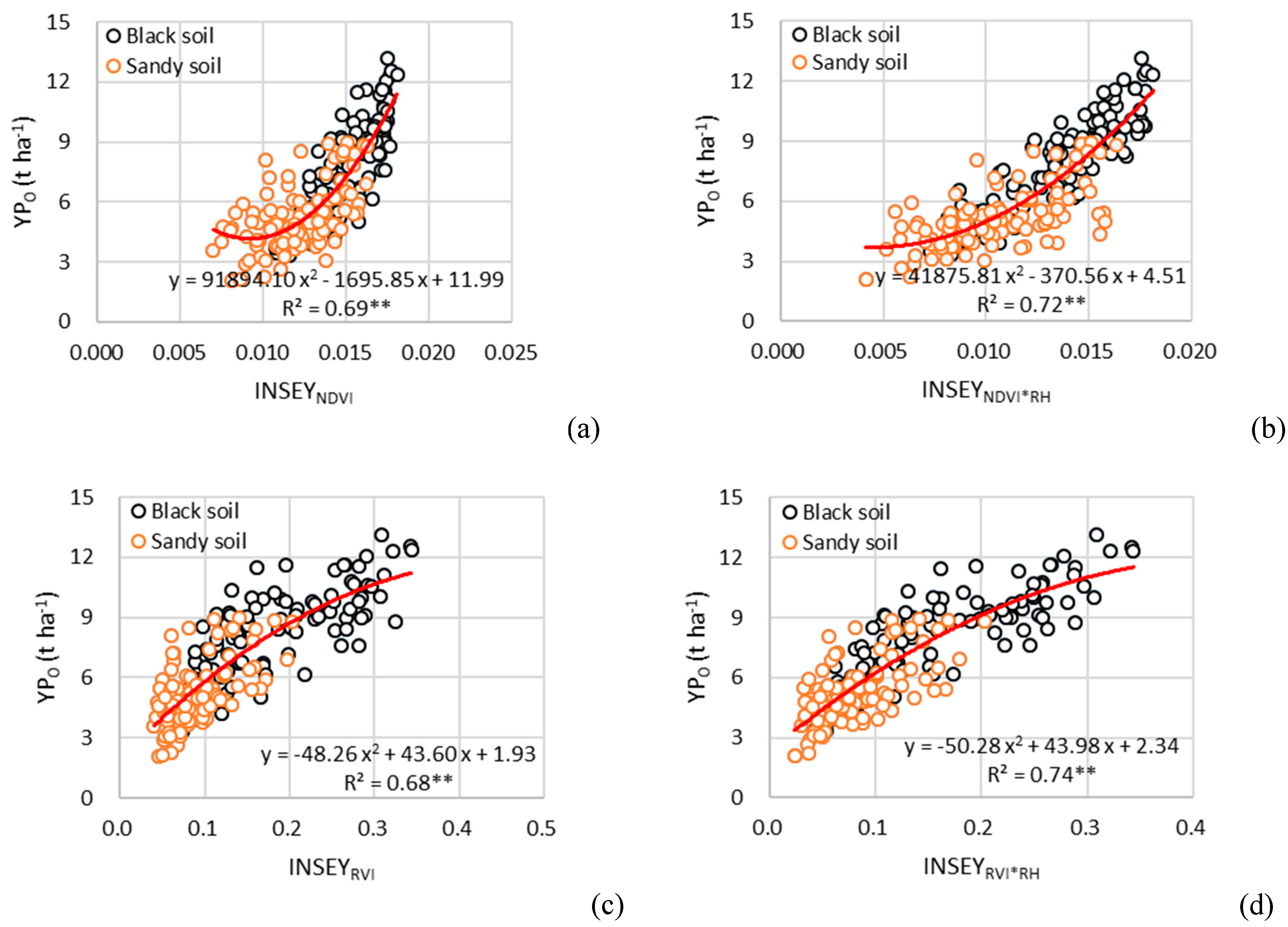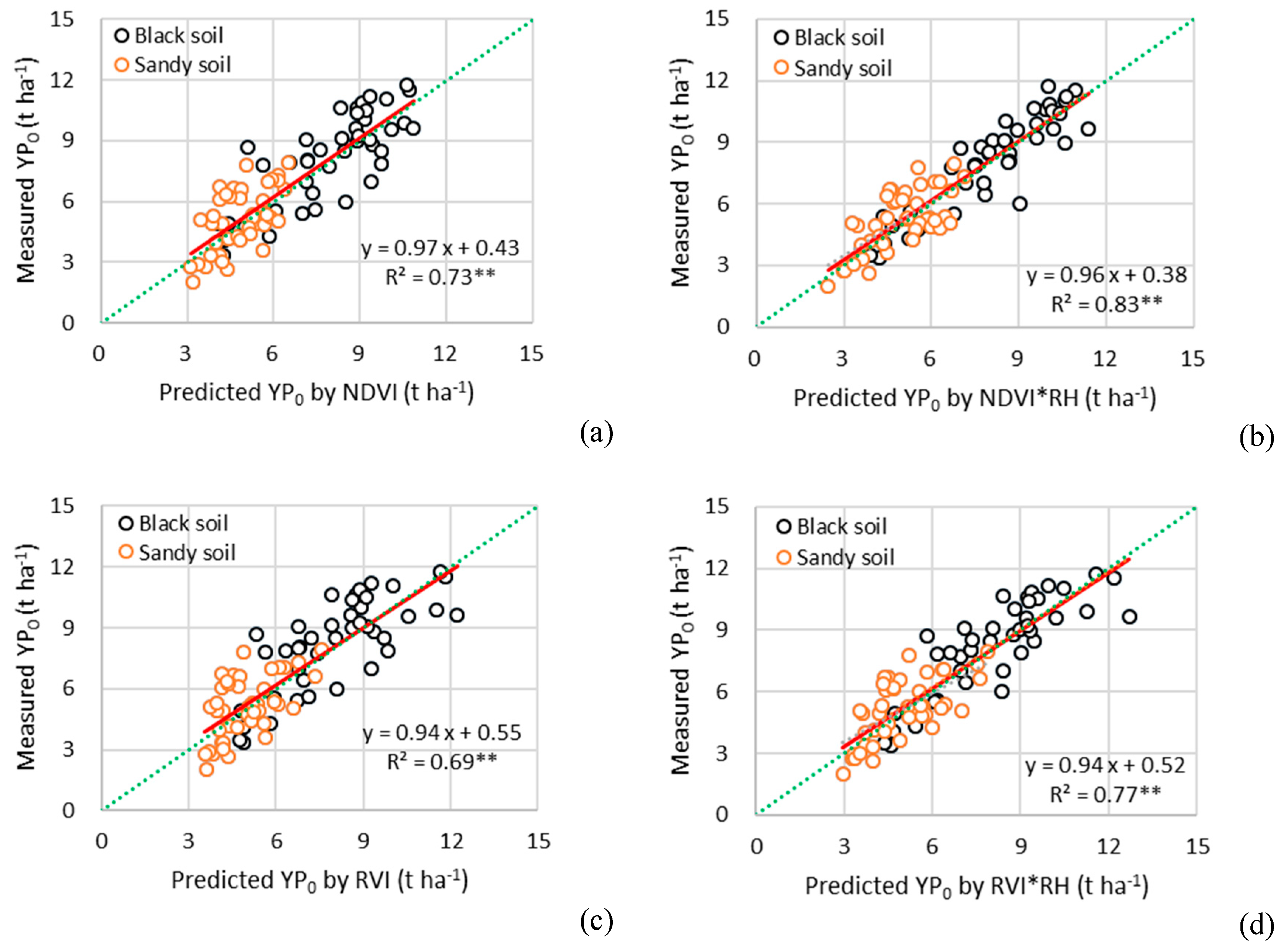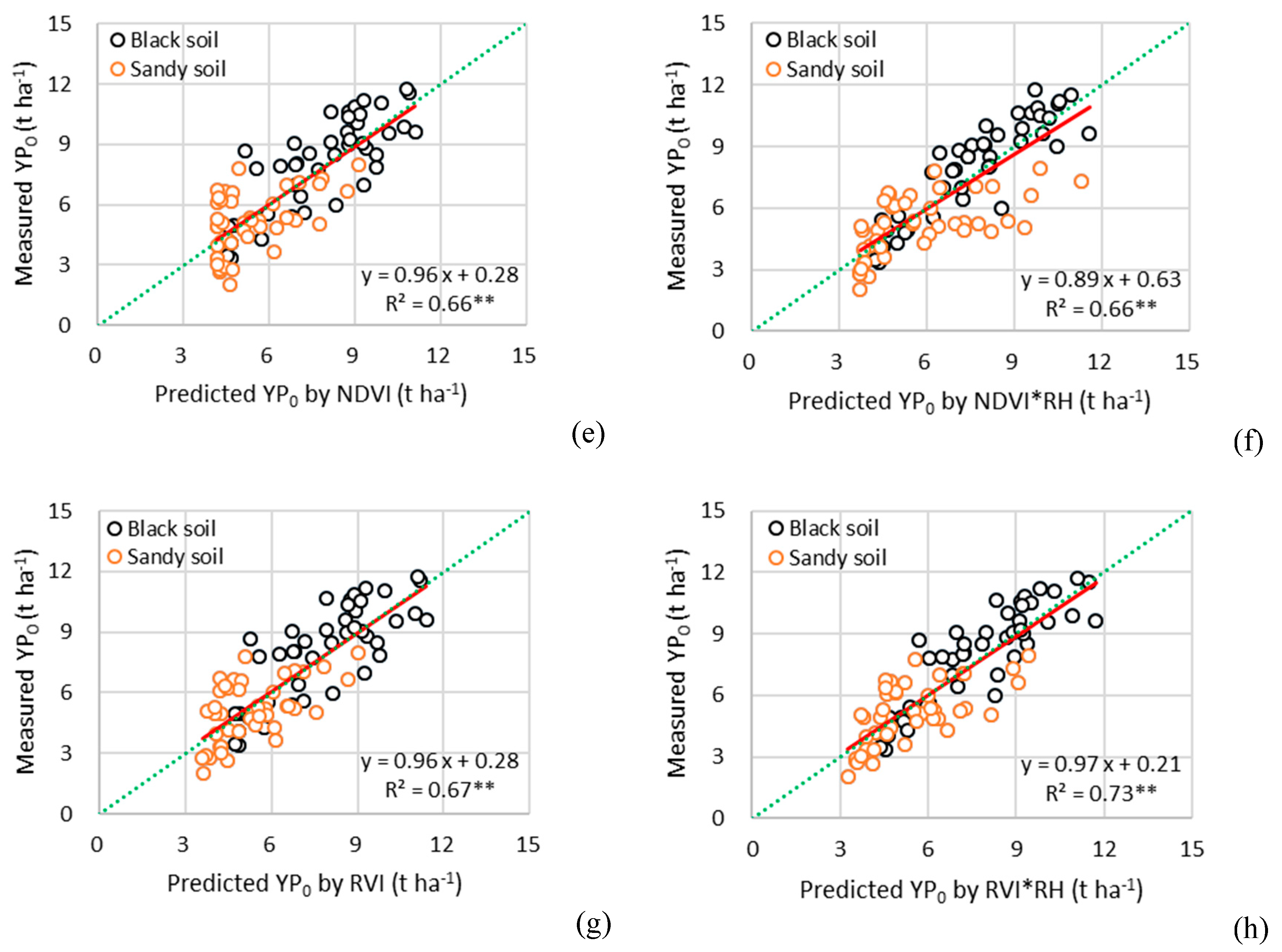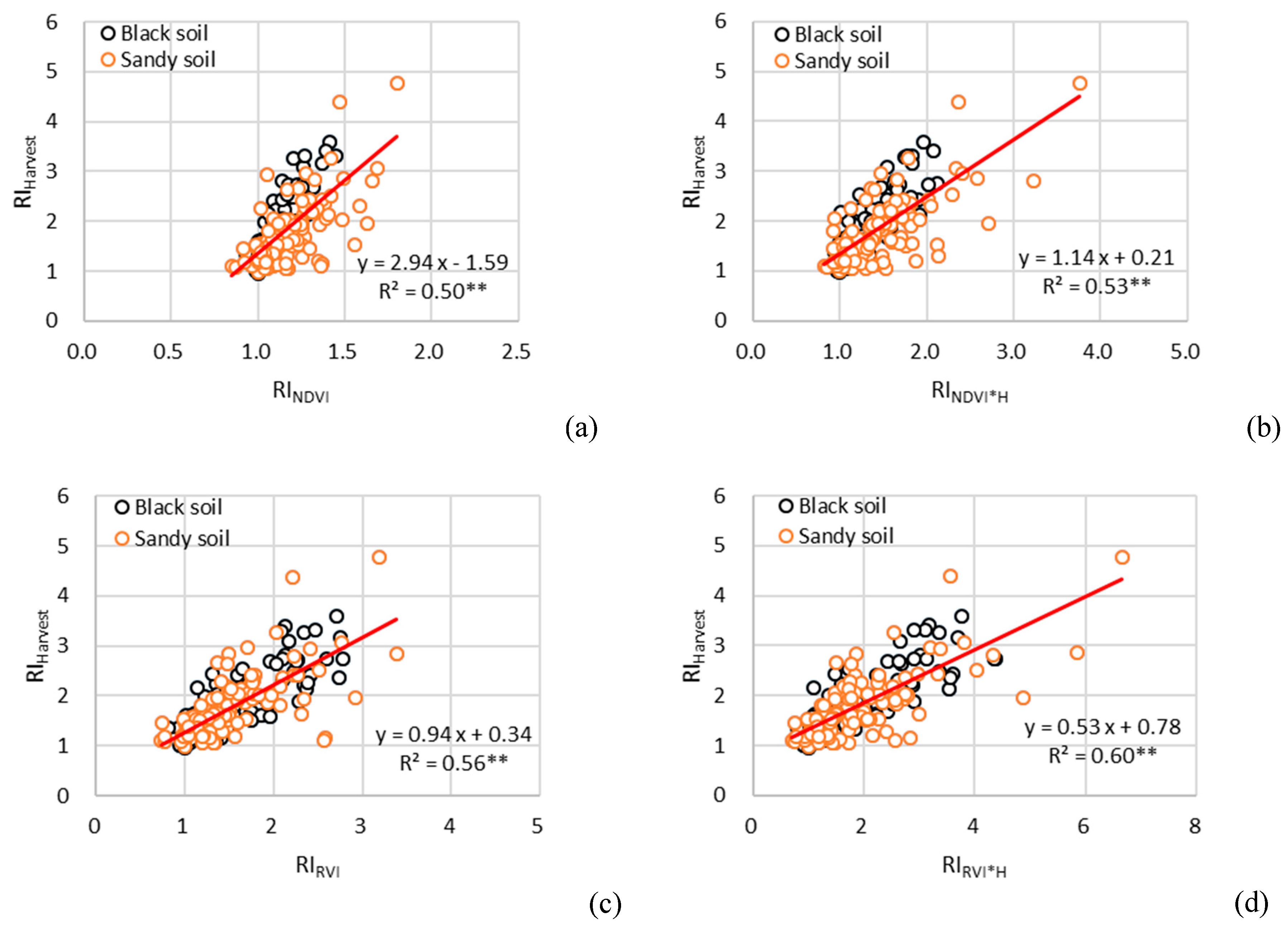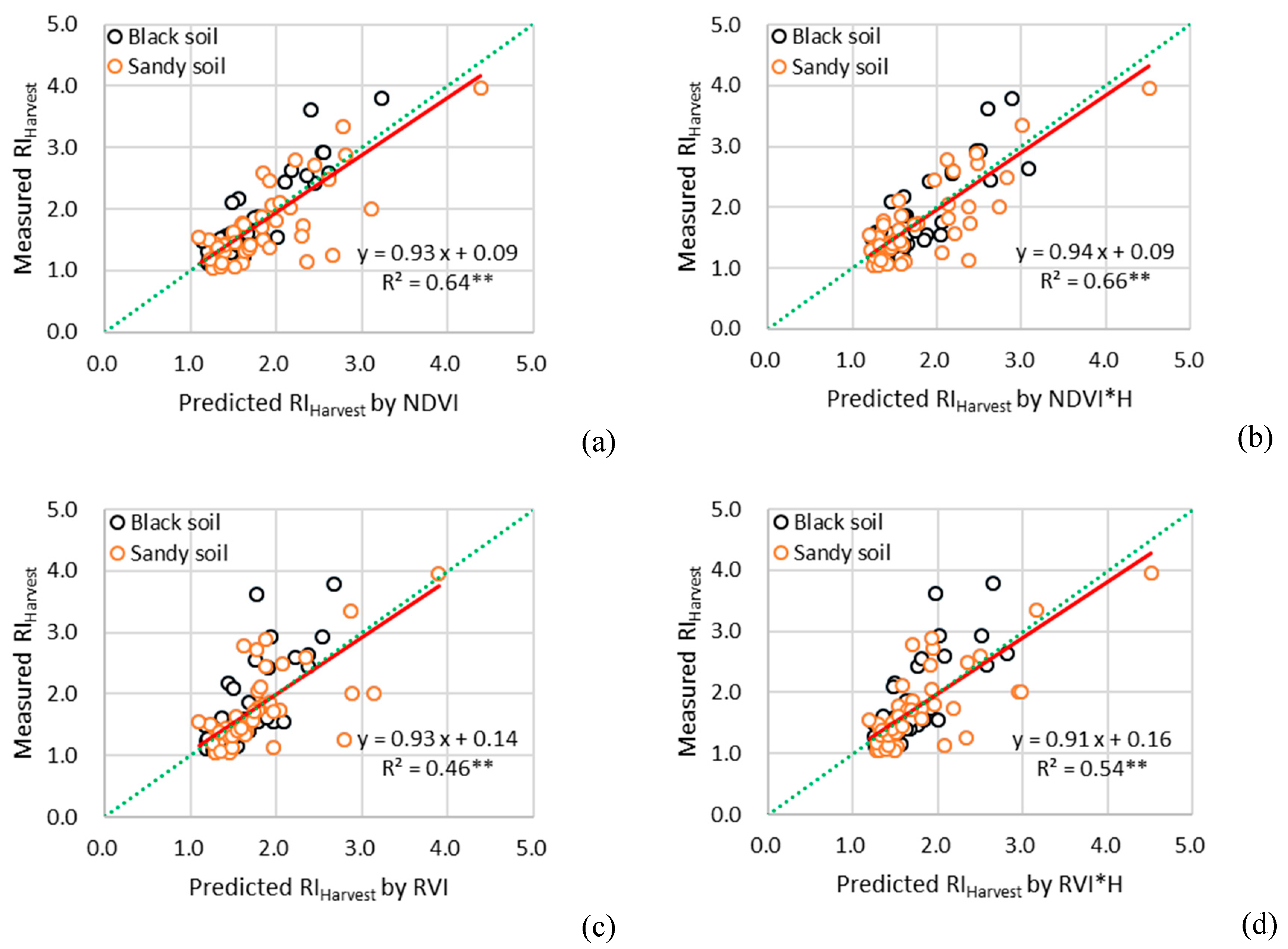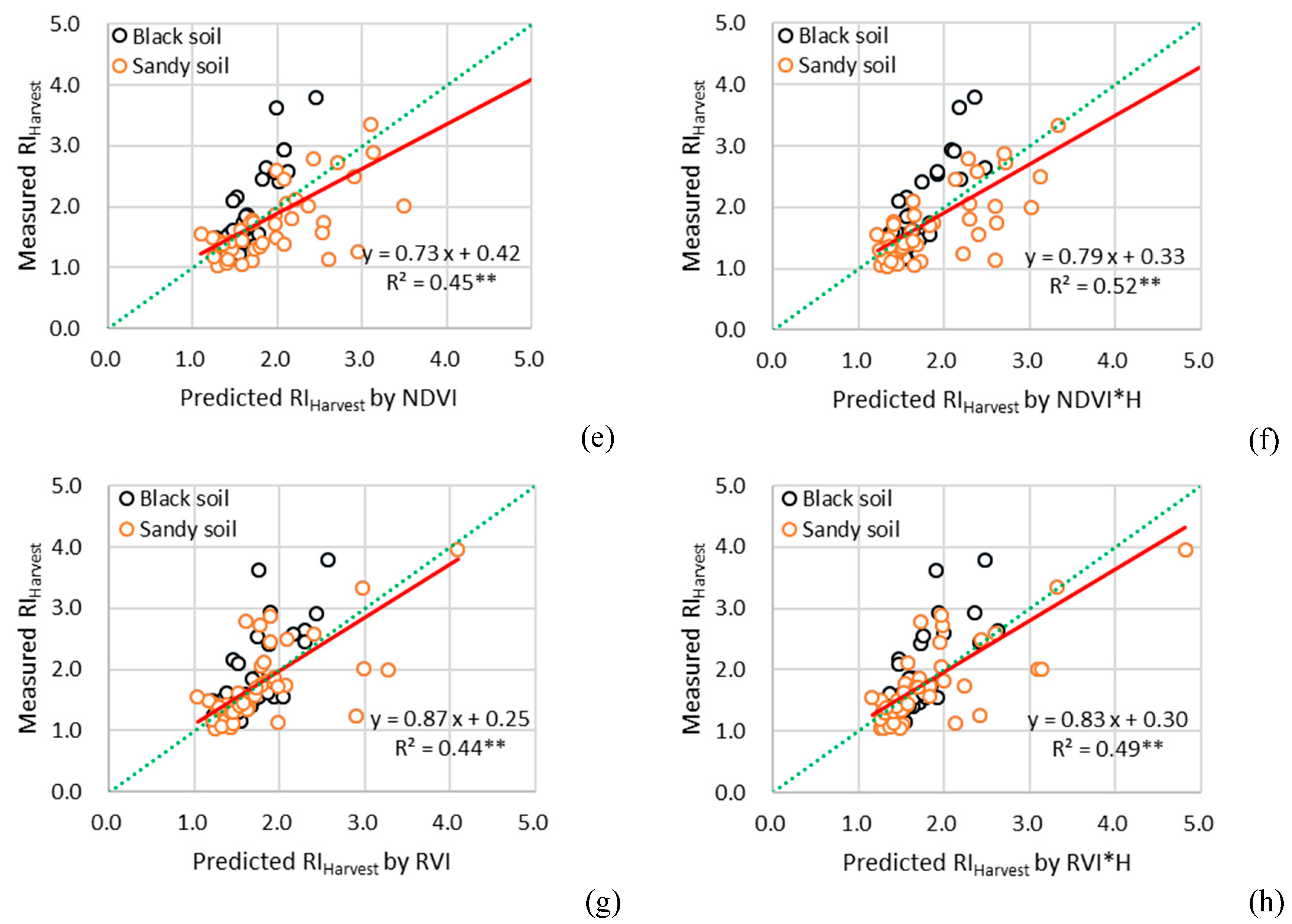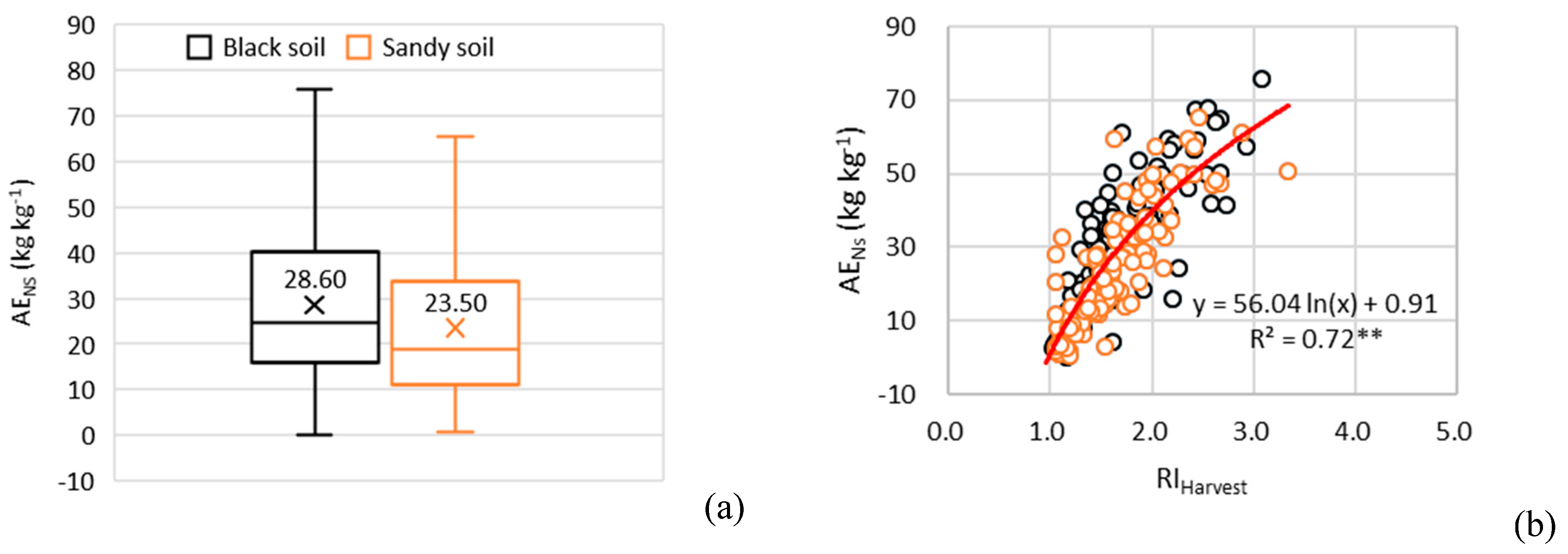1. Introduction
To achieve high grain yield and meet globally increasing food demand, over-application of nitrogen (N) fertilizer has been common in Chinese crop production [
1,
2,
3]. Currently, maize (
Zea mays L.) is the crop with the greatest demand for N fertilizer among all crops [
4]. In China, the N recovery efficiency (RE) for maize is less than 30% [
5]. Nitrogen fertilizer beyond the amount required by maize can escape from agricultural soils as reactive N (Nr), which can result in unintended adverse environmental and human health impacts [
5,
6]. Some of these environmental consequences, such as climate change and tropospheric ozone pollution, can also negatively affect crop yields [
7,
8]. N fertilizer related greenhouse gas (GHG) emissions (nitrous oxide under wet conditions and ammonia under hot conditions) have exceeded the corresponding gains in soil carbon related to its effect on increased biomass by 700% in China [
9]. Therefore, optimizing N management for maize production to minimize the adverse environmental impacts is crucially important for sustainable development of agriculture [
5,
10].
The optimum N rate depends on crop N demand and soil N supply. The crop N demand is determined by the plant growth status and grain yield potential, while the soil N supply is a net result of mineralization, immobilization and losses of soil N. They are both influenced by many factors such as seasonal temperature, precipitation, physical and biogeochemical soil properties, and management history [
11]. The interactions between soil water and N determine the growth, development and yield of maize. Efficient utilization of water and N can only be realized if they are closely matched [
12]. Climate conditions can affect optimum N via various processes in soil such as nitrification, denitrification, leaching, and mineralization, which will modulate soil N availability to the crops [
3,
13,
14,
15,
16]. Because of the temporal and spatial variability in climatic conditions and soil properties, the optimum N rate can vary widely across fields, within fields and over years in the same field [
16,
17,
18]. The low N use efficiency (NUE) in China has been attributed to the poor synchrony between N fertilizer application and crop demand in space and time [
17]. Therefore, precision N management (PNM) is needed to match N supply with crop N demand, both spatially and temporally, thereby improving NUE.
Crop growth responds to weather conditions, soil properties, and crop management. Crop growth status can reflect crop N demand and soil N supply [
19,
20]. N application rates are often adjusted for crop N requirements based on estimates of grain yield [
21]. Active canopy sensors (ACSs) are commonly used to monitor crop growth status and make in-season N recommendations [
22,
23,
24]. The GreenSeeker ACS (Trimble Navigation Limited, Sunnyvale, CA, USA) has been used to successfully predict maize grain yield potential during the growing season to improve in-season N side-dress recommendations [
24,
25,
26]. Based on the N fertilization optimization algorithm (NFOA) developed by Raun et al. [
27] using in-season estimation of yield potential and N response index (RI) estimated with GreenSeeker sensor, maize NUE was increased to 65% from 56% with a fixed rate split N application [
28]. This algorithm has been adapted to PNM strategies for rice (
Oryza sativa L.) in Northeast China, thereby increasing the N partial factor productivity (PFP) by 48% compared with farmer practices (FP), without significantly affecting rice grain yield [
29]. The algorithm has also been adapted to PNM strategies for winter wheat (
Triticum aestivum L.) and summer maize rotation in the North China Plain [
30]. This PNM strategy significantly reduced N fertilizer applications and total apparent N losses while increasing NUE compared with both FP and regional optimum N management (RONM) [
30].
In the NFOA algorithm, the first key component is the development of a model to estimate grain yield without additional N application (YP
0) based on mid-season canopy spectral measurements before side-dressing N application [
31]. The second key component is to predict the grain yield response to additional N application, which is called response index (RI
Harvest) based on the ratio of harvested grain yield under sufficient N application over YP
0. For the GreenSeeker sensor, the normalized difference vegetation index (NDVI) is closely related to crop biomass and leaf area index and has been commonly used to predict YP
0 and RI
Harvest. The NDVI can become saturated at medium to high biomass conditions, so improvements are needed, especially under high yielding conditions [
29,
32,
33,
34]. One approach is to use ratio vegetation index (RVI) calculated using the reflectance of near infrared (NIR) over red waveband instead of NDVI, because RVI is less susceptible to the saturation effect of NDVI [
29,
34]. Another approach is to combine NDVI with plant height data to improve the estimation of plant biomass or maize yield [
35,
36]. Crop plant height as a single factor can be used to estimate the vegetative growth and potential yield of maize [
37]. It is a highly sensitive growth parameter and is influenced by soil water content [
38], texture [
39], fertilizer rate [
40], and cultivation methods [
41]. A study by Machado et al. [
42] indicated that plant height data could be used to explain 90% and 61% of the spatial and temporal variations in total dry matter and grain yield, respectively. More studies are needed to determine how much improvement can be made for in-season prediction of maize YP
0 and RI
Harvest, as well as side-dress or topdress N recommendation using RVI or plant height data.
After YP
0 and RI
Harvest are predicted, the grain yield with sufficient N application (YP
N) can be estimated by multiplying YP
0 and RI
Harvest. Then, the yield response to top-dress or side-dress N can be calculated, which is the difference between YP
N and YP
0. The N requirement can be calculated by multiplying this yield difference by grain N concentration. An N recovery efficiency (RE) value is needed to further estimate the amount of N fertilizer to be applied to meet the N requirement [
27].
The N fertilizer need can also be calculated using yield response to N application divided by side-dress or top-dress N agronomic efficiency (AE
NS or AE
NT). Previously, constant NUE values were used in such algorithms. However, NUE is influenced by many factors, including N rate and timing, soil fertility status, residual N content, and environmental factors that can influence N losses through volatilization, soil denitrification, surface runoff, and leaching [
43,
44]. To improve the algorithm with more suitable NUE and grain N concentration values, Macnack et al. [
45] found that preplant N, GreenSeeker NDVI, rainfall, and growing degree days (GDD) combined and explained 76% of winter wheat grain protein content variability, but NDVI, rainfall, and average temperature combined could not predict NUE. In another study of winter wheat, 37% and 45% of NUE variabilities were explained using RI
Harvest or RI
Harvest plus RI
NDVI [
46]. More studies are needed to determine how maize NUE can be estimated in-season and how can such updated NUE can improve active sensor-based in-season N recommendations for maize.
Northeast China is the most important and the largest rain-fed maize production region of the country, accounting for 35% of China’s maize production (China’s National Bureau of Statistics, 2015). To improve the N management of spring maize in this region, the GreenSeeker sensor has been used for in-season diagnosis of maize N status, with an accuracy of 81% and 71% at V7-V8 and V9-V10 growth stages, respectively [
34]. However, no ACS-based PNM strategies have been developed for Northeast China yet. Therefore, the specific objectives of this study were to: (1) Evaluate the potential of improving in-season prediction of YP
0 and RI
Harvest by adding plant height information; (2) predict side-dress N agronomic efficiency (AE
NS) prior to the side-dress N application, and (3) develop an ACS-based PNM strategy for rain-fed maize in Northeast China.
2. Materials and methods
2.1. Study Site Description
This study site is located in Lishu County (43°02′–43°46′N, 123°45′–124°53′E), Jilin Province in Northeast China. Approximately 70% of the total cropland is planted with maize in this county. Two fields with contrasting soil types, black soil (loamy clay) equivalent to typic Haploboroll and aeolian sandy soil (loamy sand) equivalent to typic Cryopsamments according to the United States Department of Agriculture (USDA) Soil Taxonomy, were selected for this study. Soil characteristics are summarized in
Table 1. This study site is located in the North Temperate Zone, which is characterized by a semi-humid continental monsoon climate. The mean annual average temperature is 6.6 °C, the annual sunshine is 2656 h, the average annual frost-free period is 142 days, and the annual cumulative temperature (>10 °C) is 3,056 °C. The annual average precipitation is 556 mm, about 84% of which occurs during the crop growing season from May to September. The precipitation distribution and GDD during the study years (2015-2017) in Lishu County are shown in
Figure 1. According to precipitation accumulated during the whole growth period, 2015, 2016, and 2017 were considered dry, wet, and normal years, respectively.
2.2. Experimental Design
The same experimental treatments were implemented in both black and aeolian sandy soil fields from 2015 to 2017. A split-plot design with three replications was applied for the experiment, with three planting densities (D1: 55,000, D2: 70,000, D3: 85,000 plant ha−1) as the main plots and seven N fertilizer rates (N0: 0, N1: 60, N2: 120, N3: 180, N4: 240, N5: 300, and N6: 60 kg N ha−1) being the subplots. The N5 treatment was not included in the first year of this experiment in 2015, but later found to be necessary and added in 2016 and 2017. Therefore, the N4 (240 kg ha−1) treatment was used as the sufficient-N fertilizer subplot in 2015, while the N5 (300 kg ha−1) treatment was used in 2016 and 2017. The N fertilizer for N1–N5 was applied in two splits: 1/3 was broadcasted and embedded into soil as basal N using ammonium sulfate and 2/3 was band applied as side-dress N using urea at the V8–V9 stage. Each subplot with an area of 108 m2 (9 m width × 12 m length, with 1 m wide alley between the subplots) was divided into two parts: 2/3 of the subplot (part 1) received the rest of the N application at V8–V9 as planned, while 1/3 of the subplot (part 2) did not receive side-dress N application at the V8–V9 stage. Part 2 subplots were used to develop ACS-based N recommendation algorithms. For N6, all N fertilizer was applied as basal fertilizer, and data from this treatment were used for evaluating N recommendation algorithms and PNM strategies. For each plot, sufficient phosphate (90 kg P2O5 ha−1) and potash (90 kg K2O ha−1) fertilizer were applied before planting to make sure P and K nutrients were not limiting. The same local maize variety (Liangyu 66) was used in both fields. No irrigation was applied during the plant growth period for black soil field, while one-time irrigation of about 50 mm of water was applied before the anthesis growth stage in the aeolian sandy soil field each year. All plots were kept free of weeds, insects, and diseases with chemicals based on standard practices. These experiments were conducted in the same fields in all the three years.
2.3. Active Canopy Sensor Data Collection and Plant Sampling
The GreenSeeker ACS Model 505 was used in this study. This sensor detects crop canopy reflection in red (R: 650–670 nm) and near-infrared (NIR: 755–785 nm) spectral regions, allowing calculation of the NDVI and RVI [
47]. At V8–V9 stage, the GreenSeeker sensor readings were collected by holding the sensor at approximately 0.7 m over the maize canopy in each subplot (four rows in the middle of subplots, and three meters length for each row) and walking at a constant speed. The sensor data from different rows in a subplot were averaged to represent that subplot. The NDVI and RVI values were calculated directly by the built-in software of the GreenSeeker sensor. After sensing, three representative plants were selected and plant height was measured manually from the stem bottom to the leaf top by extending the uppermost leaf as high as possible in each subplot. At the maturity stage, grain yield was determined by manually harvesting eight lows with three meters in length except the border rows in each subplot and standardized to 14% grain moisture content. The stem, leaf, and grain were separated and oven-dried at 105 °C for 30 min, then dried at 70 °C to a constant weight, and finally weighed to obtain the plant aboveground biomass (AGB), later they were ground into fine powder to determine plant nitrogen concentration (PNC) by a modified Kjeldahl digestion method [
48].
The GreenSeeker sensor data were missing from the aeolian sandy soil field in 2015, but a Crop Circle ACS 430 sensor (Holland Scientific, Inc., Lincoln, NE, USA) was used to collect reflectance data in all the study fields and yields. The measurement method for the Crop Circle ACS 430 sensor was similar with the GreenSeeker in the sensing position, time, height, and speed. Strong relationships were found between the NDVI and RVI values from Crop Circle ACS 430 and GreenSeeker (
Figure 2), and as a result, the GreenSeeker NDVI and RVI values in the sandy field in 2015 were converted from NDVI and RVI values of Crop Circle ACS 430 sensor.
2.4. The Development of N Fertilizer Recommendation Algorithm
Plant height can vary among varieties with the same N conditions, as well as from year to year due to seasonal conditions within the same variety. Therefore, we normalized plant height measurement in this study and used the relative height (RH) together with vegetation. It was calculated as follows:
where H was plant height, TSP was test subplot, SNSP was sufficient-N fertilizer subplot (SNSP).
Grain yield potential without side-dress N fertilizer (YP
0) was estimated using the in-season estimate of yield (INSEY) based on NDVI (RVI) or NDVI (RVI) with RH (INSEY
NDVI, INSEY
RVI, or INSEY
NDVI*RH, and INSEY
RVI*RH). They were calculated as follows:
where the GDD was the number of growing degree days greater than zero from planting to sensing.
The grain yield response index to side-dress N fertilizer (RI
Harvest) was calculated using the average grain yield in the subplots receiving sufficient N fertilizer divided by the grain yield from a test subplot. RI
Harvest values were also estimated using the RI
NDVI and RI
RVI or RI
NDVI*H and RI
RVI*H at V8-V9 stage, which were calculated using average vegetation index in the subplots receiving sufficient N fertilizer divided by the average vegetation indices in a test subplot receiving different N rates. They were calculated as follows:
AE
NS was defined as the increased grain yield due to side-dress N application divided by the side-dress N fertilizer rate. In this study, AE
NS was calculated by dividing the increased grain yield (the grain yield from subplot part 1 minus the grain yield from subplot part 2) by the side-dress N fertilizer rate. It was calculated as follows:
where N
SD was the side-dress N rate, kg ha
−1.
The YP
0, INSEY, RI
Harvest, and RI based on vegetation index data were randomly divided into two datasets: 70% of the data were used to establish models for estimating YP
0 and RI
Harvest, and 30% of the data were used for validation. The YP
N was calculated by multiplying the predicted YP
0 and the predicted RI
Harvest. Then the recommended N rate (Nrec) was calculated by dividing the difference between YP
N and YP
0 by the average AE
NS. In this study, an improved NFOA (INFOA) was developed by using in-season predicted AE
NS based on the in-season predicted RI
Harvest. They were calculated as follows:
2.5. The Evaluation of N Recommendation Algorithms and Precision N Management Strategies
After the in-season YP0, RIHarvest and AENS prediction models were established and validated, sensor data from the subplot N6 (only receiving 60 kg N ha−1 as basal N rate) at three planting densities were used to calculate the N recommendation rates using different N fertilizer recommendation algorithms at the V8–V9 stage. The economic optimum N rates (EONR), defined as the optimum N application rate resulting in the highest marginal return, were used to evaluate different N recommendation algorithms based on the GreenSeeker sensor.
The sensor-based PNM strategies were evaluated in terms of grain yield, marginal return, and NUE in comparison with the farmer practice (FP) and regional optimum management (ROM). For the black soil field, we defined the treatment with planting density of 70,000 plant ha−1 and base N rate of 60 kg N ha−1 (N6) as PNM treatment, and the treatment with planting density of 55,000 plant ha−1 and total N rate of 300 kg N ha−1 as FP treatment and the treatment with planting density of 70,000 plant ha−1 and total N rate of 240 kg N ha−1 as ROM treatment. For the aeolian sandy soil field, we defined the treatment with planting density of 55,000 plant ha−1 and base N rate of 60 kg N ha−1 as the PNM treatment. The FP and ROM treatments were the same as in the black soil field.
In this study, the grain yield and plant N uptake (PNU) from the different N recommendation algorithms and PNM strategies were calculated from the N response models of grain yield and PNU developed using data from treatments N0–N5.
The NUE indicators, partial factor productivity (PFP), agronomic efficiency (AE), and recovery efficiency (RE) were calculated using the following equations:
where Y
N and Y
0 were the grain yield in N fertilizer application subplots and 0 kg N ha
−1 subplots, respectively, and PNU
N and PNU
0 were the PNU in N application subplots and 0 kg N ha
−1 subplots, respectively, and N
F was the applied N fertilizer rate.
The N surplus (NS) was defined as N fertilizer application rate (NF) minus PNU, which was calculated by multiplying plant N concentration by biomass.
The economic income, defined as marginal return to N (E,
$ ha
−1), was calculated according to formula (16):
where Y was the grain yield (kg ha
−1), P
Y was the grain price (
$ kg
−1), N
F was the N fertilizer application rate (kg ha
−1), P
N was the N fertilizer price (
$ kg
−1). The prices of maize grain and N fertilizer were 0.31 and 0.62
$ kg
−1 in China, respectively [
46].
2.6. Statistical Analysis
The standard deviation (SD), mean, and coefficient of variation (CV, %) of maize yield indicators were calculated using Microsoft Excel (Microsoft Corporation, Redmond, WA, USA). The coefficient of determination (R2) relating vegetation indices with yield indicators was calculated using SPSS 19 (SPSS Inc., Chicago, Illinois, USA). The overall performance of the established relationships was estimated by comparing R2 and root mean square error (RMSE) of prediction. The higher the R2 and the lower the RMSE, the higher the precision and accuracy of the prediction models. The N response models of grain yield and plant N uptake to N rate were determined by SAS Version 8.0 (SAS Institute Inc., Cary, NC, USA). The least significant difference (LSD) test at 5% and 1% probability levels were used for the analysis of difference.
